At WiseGEEK, we're committed to delivering accurate, trustworthy information. Our expert-authored content is rigorously fact-checked and sourced from credible authorities. Discover how we uphold the highest standards in providing you with reliable knowledge.
What is the Labor-Management Relations Act?
Passed into federal law in the United States in 1947, the Labor-Management Relations Act places limits on the activities of labor unions. Also known as the Taft-Hartley Act, this law addressed the interactions of management and labor unions, rules for striking organizations and the rights of the federal government to act in certain situations. The Labor-Management Relations Act made many amendments to the Wagner Act, a federal law from 1935 that helped legalize labor union activity.
The Labor-Management Relations Act was written primarily by Mack Swiger of the Taft, Stettinius and Hollister law firm. It was sponsored in Congress by Senator Robert Taft and Representative Fred Hartley, Jr. However, after its initial passage through both the House of Representatives and the Senate, it was vetoed by President Harry S. Truman. This veto was overridden on 23 June 1947, resulting in the law being added to Title 29 of the United States Code.

The Labor-Management Relations Act enforced additional rights for the management structure of companies with labor unions. Previous laws prohibited certain actions by management, but the Taft-Hartley Act focused on limiting the power of labor itself. Various laws were put in place regarding certain types of strikes, picketing and boycotts. Additionally, workplaces that required the hiring of union members were limited. Since this was the beginning of the era of McCarthyism, union leaders also were required to sign affidavits that supported anti-communist activities.

Certain incidents following the end of World War II prompted the creation of the Labor-Management Relations Act. After Japan surrendered and the war drew to a close, over five million American workers were involved in strikes within one year. Radicalism and communist activities became a major concern for authorities as general unionization became more prevalent. In response, approximately 250 separate bills were introduced during the Congressional session of 1947, culminating in the passage of the Taft-Hartley Act.
Following the passage of the Labor-Management Relations Act, the unions became strongly associated with the Democratic Party. Despite certain limitations imposed by the law on the funding of federal candidates by labor unions, the organizations continued to supply financial contributions to the Democrats, linking the two politically. Truman ran for reelection in 1948 on the principles that the law would be repealed, but failed in his actions after the vote. The party's opposition to the mandate continued over the years, particularly during the administrations of Presidents Carter and Clinton. However, strong Republican opposition prevented the change during every attempt.
AS FEATURED ON:
AS FEATURED ON:












Discussion Comments
@irontoenail - The problem is that finding the balance is really difficult. There are places in the world right now where labor unions are being stamped out all together.
And then they get to put laws in place like the ones where you can be put on probation for six months on a low wage and with no job security and then fired before your employer has to start paying you benefits.
Or ones where there is a minimum wage that wouldn't support a hamster, leaving people desperate and turning to loans and credit cards to get by.
Sure, unions can overreach sometimes, but I still say they are better than the alternative.
I'm all for labor unions in general, but in practice I think they should be bound by law to some extent. I don't really know all the particulars of this law of course.
I just know that at the moment it is almost impossible for a teacher to be fired in some places. Which is great if you're the teacher, but not so great if you are the students.
And it came about because of a very strong labor union which could manipulate public concerns about strikes.
On the other hand it is better than teachers not getting paid much at all and having no job security. People just need to find a balance.
Post your comments